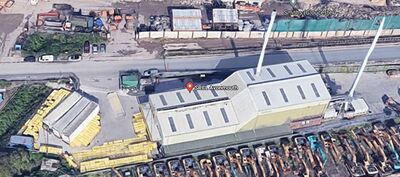Avonmouth Clinical Waste Incinerator
Clinical Waste Incinerator operated by SRCL and located in Avonmouth, with an annual capacity limit of 6,570 tonnes.
| Avonmouth Clinical Waste Incinerator | |
 See HT & Clin → page for a larger UK Wide map. | |
| Waste Licence | VP3130EF |
| Operator | SRCL |
| Operational Capacity | 6,570tpa |
| Number of Lines | 1 |
| Region | South West |
Annual Report Data
| Year | Total In | Total Clinical | IBA Out | ACP Out | Op Hours
|
|---|---|---|---|---|---|
| 2019 | 4887 | 4887 | 653 | 335 | 7516 |
| 2018 | 4234 | 4234 | 599 | 349 | |
| 2017 | |||||
| 2020 | 4538 | 4538 | 575 | 323 | 7498 |
| 2021 | 4155 | 4155 | 607 | 288 | 7148 |
| 2022 | 4802 | 4802 | 586 | 195 | 7637 |

Summary
Clinical Waste Incinerator operated by Stericycle (SRCL) and located in Avonmouth, Bristol. It is designed to process 750 kilgrams per hour[1] with an annual capacity limit of 6,570 tonnes.
The Avonmouth plant incinerates clinical waste, including clinical wastes classed as hazardous under the Hazardous Waste (England and Wales) Regulations 2005. The bulk of the waste is produced at hospitals, but also includes smaller quantities from doctors’ surgeries, dentists, health clinics, residential and nursing homes, and from medical research facilities. The hazardous wastes incinerated include infectious waste and waste containing cytotoxic or cytostatic medicines[1].
The plant also incinerates small amounts of specialised wastes where it is recognised that high temperature incineration represents the best disposal option[1].
Plant[2]
The Avonmouth Clinical Waste Incinerator is of stepped hearth design, with three main combustion hearths and an ash box. Healthcare wastes are loaded mechanically direct from the wheeled bins used to deliver the waste, into the inspection cradle which provides the opportunity to visually inspect the waste before it is tipped into the incinerator charging hopper.
The waste is discharged into the loading box and is pushed from there onto the first hearth where the combustion process commences. Hydraulic rams operate at intervals to push the waste along the first hearth, until it falls off the end onto the second hearth where it burns vigorously at a temperature of between 850°C and 1000°C, where it burns out to produce an ash. This bottom ash and any remaining part-combusted waste is then pushed onto the last hearths, where the fixed carbon in the ash is further burned out. The retention time of the entire process is between 4-6 hours. The residues are then dropped into an ash quench pit at the end of the process before being transferred into a skip. Ram movements are programmed in relation to the number of bins fed.
The flue gases from the Incineration process then pass through a secondary chamber, or afterburner, where any gaseous products of Combustion are burned out under oxygen rich conditions. This stage is designed to destroy any Carbon Monoxide, Volatile Organic Compounds, and dioxins and furans produced by the Combustion process. Ammonia in the form of urea solution is injected into the secondary chamber for further control and reduction of oxides of nitrogen emissions.
The flue gases are then cooled by passing through a waste-heat boiler and economiser, before passing into the final, abatement section of the process. Powdered lime (Calcium Hydroxide) and powdered activated carbon are added to the flue gases entering the abatement process to remove acid gases, heavy metals and residual dioxins and furans before discharge to atmosphere from the stack. The flue gases being discharged from the stack are continuously monitored for Hydrogen Chloride, Sulphur Dioxide, Carbon Monoxide, Oxides of Nitrogen, particulate matter (dust), Volatile Organic Compounds, oxygen, Ammonia and nitrous oxide.
The incineration process produces two residues; bottom ash and spent lime.
